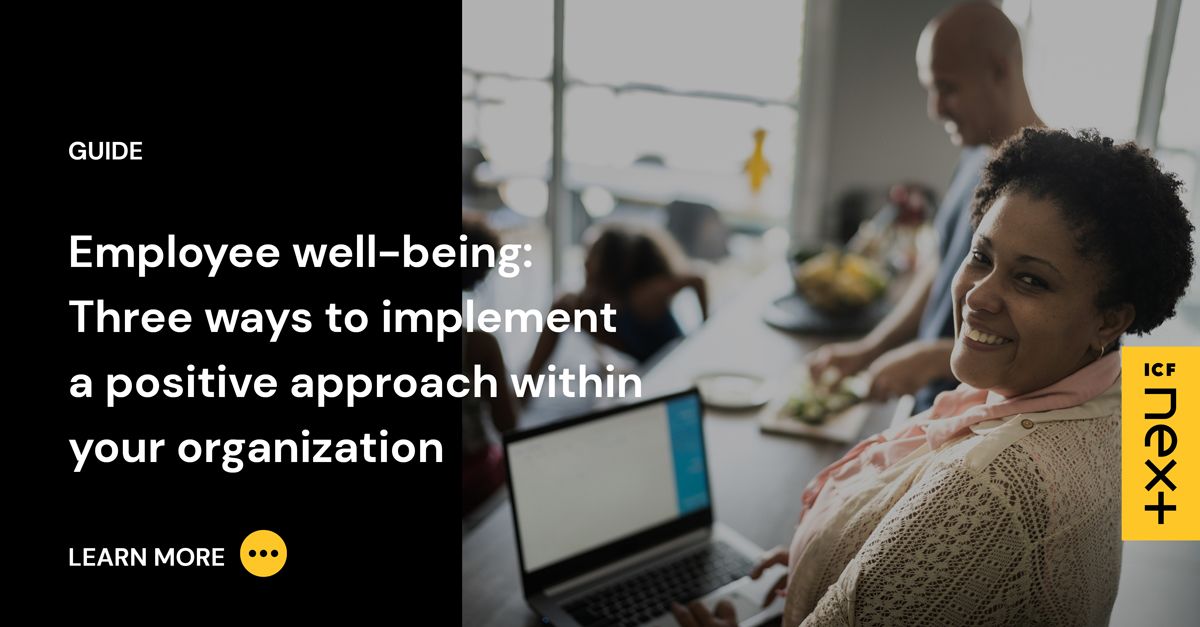How to create a proactive approach to employee well-being
How responsible employers should respond
Place employee well-being at the heart of your hybrid strategy for the future of work. Recognize the threats posed by the global mental health pandemic and hardwire well-being strategically into your system. Fold it into job roles, incorporate it into the conversations that managers have with their teams, and make it a part of the everyday fabric of working life. That fundamental culture change can help prevent well-being problems from occurring in the first place.
“Well-being isn’t a survival mechanism for work. It should be integrated into the fabric of how we work.”

Integrate well-being into the employee experience
How will integrated well-being alter an employee’s experience? What impact will that shift have—both internally and externally?
Internally, an integrated approach normalizes well-being. It creates awareness and concern for well-being within the workplace. It shifts perspectives and employees who work in cultures that prioritize and promote well-being learn to embrace the support—to do their jobs better, without judgement.
A proactive approach to well-being has tangible external benefits as well. When organizations build well-being more fully into the employee experience, it has a direct, positive influence on employee advocacy. When employees feel happy at work, positive sentiments shine through their conversations with family and friends. That positive external impact should be a strong motivation for any organization to get its approach to well-being right.
Why organizations should focus on social well-being
Organizations need to provide integrated and proactive well-being support for their employees. The common elements we see in current well-being programs are those that support physical, mental, and financial well-being. There is a fourth element of well-being—social well-being—that’s often left behind.

Social well-being is more important than ever. Due to the disruption of many of their usual support structures, more people are feeling isolated and stressed. How can organizations help put those structures back in place?
One option is to build well-being networks within your organization. While many organizations have well-being resources located on their intranet site, a well-being network can act as the first point of contact to offer immediate support or help colleagues find the resources they need. It’s important that the internal network and support system you establish are properly trained. They should be comfortable having conversations with colleagues, not just when well-being is at stake, but regularly, as a part of normal working life.
To succeed, well-being support cannot be the concern of only a few key people within an organization. Everyone within the organization needs to have an open approach to talking about mental health within the workplace. Only then will well-being truly become a part of the fabric of the entire employee experience.
How organizations can best implement a proactive approach to well-being
To lift well-being to the level it deserves within organizations and their future of work, we suggest three practical steps:
1. Engage and empower line managers
Line managers are among the most important element in promoting a positive well-being message to your employees and driving real culture change within your organization. Assess how equipped they are to have the right kinds of conversations with their teams. Explain why a proactive approach to well-being is important and how they can impact on that cultural shift. Provide managers with the skills and resources they need to start a more proactive dialogue around well-being. Supply them with well-being experience principles, get data through employee engagement surveys, hold focus groups, and establish a dedicated well-being hub to act as a digital home for employees and includes resources for managers.
2. Break down barriers
A principal aim for all your communication should be to remove any judgement around well-being. Show employees that looking after all aspects of their health is the best way to boost individual and organizational performance.
Language plays a vital role in the reframing of your organization's well-being narrative. Try to drive open and honest conversations. Be sure to arm your employees with the language they need to have more positive conversations around well-being.
3. Make it personal
Keep messaging around well-being as personalized as possible. Make well-being communication relevant to the audience you want to support. Ideally, you should take a multi-channel approach to reach the right people, in the right place, at the right time. We recommend a mix of always-on, push-and-pull communications to create a powerful blend of messaging that builds awareness and engagement.
Build the future of work around a new approach to well-being
Organizations must shift from a reactive well-being approach to a proactive one. Focus on rebuilding key relationships between employees and fostering open communication in a judgment-free environment.
Give employees the training and skills needed to have the right conversations and the right tools to create hybrid workplaces where well-being is a part of everyday life.
In the future of work, we hope positive mental health and holistic employee well-being are the recognized way for us all to be at our best—personally and professionally—for ourselves, our colleagues, and society.
